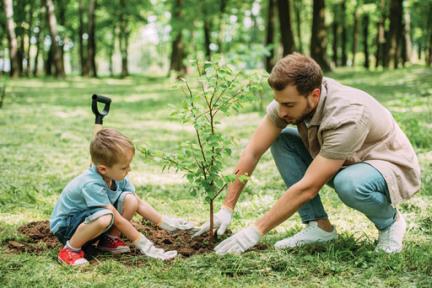
By Stephen Brueggerhoff, CEA/Horticulture; Texas A&M AgriLife Extension Service
This is the time of year to be planting your landscape with ornamental, fruit, and citrus trees. Let’s dig in with a brief review of site selection and planting basics for the sustained health and productivity of your trees.
The success of any planting starts from the ground up. Invest in the sustainability of your planting by committing to a soil test. Soil tests provide a basic measurement of existing nutrient availability, pH range and salinity levels at the planting site and help guide you in choosing a tree appropriate for your site. Establishing your tree also relies on a site with well-draining soil, and committing a percolation test will help with tree location. To commit a perc test, dig a hole at your chosen site 18-inches wide by 24-inches deep, fill the hole with water and let stand for an hour, then refill with water to the top. Measure water drop beginning at three hours, and then every hour for an additional three hours to estimate an average percolation rate. Drainage measured at more than 1-inch per hour is ideal (well-draining) for fruit and citrus, and half an inch to 1-inch per hour is acceptable for most ornamental species. Building a raised bed is an option for fruit and citrus trees and utilize the native topsoil to create a 6- to 10-inch-high mound approximately 10-feet wide for each tree. Remember to orient your fruit trees with full sun exposure to encourage adequate production. A general rule of thumb for spacing between standard sized fruit trees is 20-feet, and always take into consideration whether the tree is semi-dwarf or dwarf species regarding spacing.
Late winter is the best time to plant your trees from either container or bare root, and between mid-January to late February. Our goal is to encourage good root development during this dormant season and prior to leaf emergence. Pruning one-third of the top of fruit trees like peach, nectarine, pear or plum at planting is a standard to create future canopy structure. Citruses are evergreen trees, and the canopy is left intact when planting. Care should be taken to protect the top growth of tender citrus varieties after planting in case we receive a late freeze. Other than pruning broken branches, an ornamental tree canopy is left intact when planting.
If you choose delivery of bare root trees, open the bundles immediately and check for damage and general condition. Do not accept the trees if the roots appear to be dried out. You may decide to heel in the trees in a shallow trench if you are not ready for planting by covering the roots with moist soil for protection. Prior to planting, soak the bare roots in water for no more than an hour for hydration. I recommend root washing all the media off containerized plants to examine the root structure and prune malformed roots as needed. For planting prep, dig a hole as deep in approximate proportion to the root system. A general recommendation is no deeper than the size of the container or length of a bare root tree. For bare root planting, create a small cone in the center of the hole to support the tree and fan out the roots around the cone. Use the native soil to backfill the hole, gradually placing layers of soil and preventing air pockets from forming around the roots. Compost and organic matter serve the planting best when applied around and at the surface of the tree rather than blending with the backfill. Apply water in the hole when half-filled and let drain, then water well when you are finished with planting.
Whether you are thinking of trees for shade or trees for fruit, we’ve got you covered with upcoming programs. Join Galveston County Master Gardener Briana Etie for a free seminar Tree Selection for the Home on February 10, presenting tree selection for our area, maintenance, and planting tips. We’ve got Burr Oak saplings to giveaway for the first 20 people attending. For fruit, citrus, spring veggies and more, our Galveston County Master Gardeners are hosting Ready, Set, Spring! Plant Sale online February 16 and 17. Great selections to purchase and fit your needs. Find out more by browsing to our website: https://txmg.org/galveston. Tree cheers to you, my friends, and I’ll see you in the garden.

